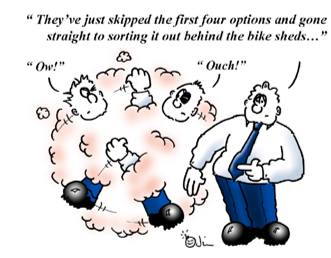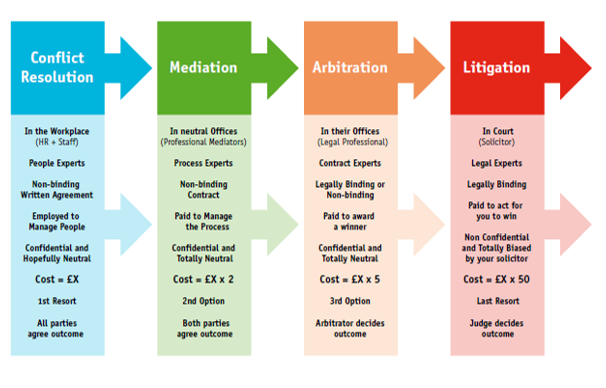Ruth Murray-Webster and Peter Simon
 An ability to manage conflict is fundamental for effective project management. In previous Lucid Thoughts we’ve shared some ideas about how to do that well including the “hard on the issue, soft on the person” principles underpinning the martial art of Aikido.
An ability to manage conflict is fundamental for effective project management. In previous Lucid Thoughts we’ve shared some ideas about how to do that well including the “hard on the issue, soft on the person” principles underpinning the martial art of Aikido.
Conflict, of course, is inevitable. Some would argue it is also desirable as from difference creativity, innovation and value can flow.
But this is not always the case. Conflicts can turn nasty at which point we tend to call them disputes. In this Lucid Thought we want to share some ideas about the options if your conflict management attempts don’t work and you find yourself with a dispute to manage.
To us, there are four options to consider if conflict management doesn’t work. The first might seem a little odd to you - Conflict Resolution. We separate it as the process and skills needed to resolve a conflict which are different from those for day-to-day conflict management. Conflict Resolution is often grouped together with Mediation and Arbitration under the title Alternative Dispute Resolution or ADR. Litigation may be chosen instead of ADR, or may be the last resort if ADR doesn’t work.
A summary of each of the four options is shown in the figure. You’ll see that different people are involved, the decision-making processes vary and the costs and outcomes are very different.

Conflict Resolution
Carried out by someone who is not directly involved in the project, this is a process focused on trying to get all the parties to agree an outcome that they can work with without redress to higher costs and external involvement. The Conflict Resolution process is often facilitated by an internal person, for example someone from Human Resources.
Alternatively a specialist in this area can be brought in from outside the business. We know because one of our team does this. Creative Conflict Resolution relies on a process that can address the following eight points:
- Use a Win/Win approach (even if you can’t get a Win/Win outcome)
- Look for creative responses
- Be empathetic
- Use appropriate assertiveness
- Engage power co-operatively
- Manage emotions
- Have a willingness to resolve
- Broaden perspectives
Mediation
This is always an externally driven process. External mediators are readily available, they will take you through a process where they will encourage both parties to explain their understanding of the issues i.e. what is in dispute, acknowledge both positions and guide both parties towards a mutually acceptable agreement using non-adversarial strategies. It’s the next best option to conflict resolution in terms of cost - but the outcome is non-binding in legal terms, an agreement is reached if possible.
A simple example of a Mediation process might be:
-
Open. Create the correct environment for the meeting. Define the
role of the mediator. Agree behaviour required during process. -
Establish. Each person describes what the issue is from their point of view and how they feel about it? Map the detailed needs and concerns. Clarify misperceptions. Check to ensure all parties are hearing the key points.
-
Move. Find areas of agreement. Generate options. Parties Negotiate. Use private meetings for parties to consider and clarify where they are.
-
Close. Contracting. Checking. Agreeing to Review. Acknowledging.
Arbitration
The next resort is the halfway house between the parties agreeing a way forward between them, and a Judge deciding what will happen. The Arbitrator will have legal training but may not be a lawyer.
Their decision can be legally binding or non-binding depending on the criteria of the process agreed at the outset. It can happen that one or both of the parties think and feel that they have been let down by the process. Arbitration is most often used to settle contractual or commercial disputes. Rather than going to court or Mediation, the parties can agree in advance (in the contract) that Arbitration will be used to settle any disagreements.
Arbitration is typically much quicker, simpler, and cheaper than litigation.
Litigation (The Law)
Litigation is not part of ADR and should be the position of last resort in any dispute. It is a very expensive process that can generate more issues than it resolves. Many people that have been through the court process will probably tell you to avoid it at all cost and for the following reasons.
- The cost of legal representation.
- The cost of business time.
- The cost of the stress on team members.
- The cost of repairing the relationship with the other party or finding another partner to work with.
- The cost of the loss of reputation of your business, win, lose or draw!
On most occasions one or both the parties think and feel that they have not had justice and because of this many go to appeal. Some parties never forget the pain, humiliation and dread of being cross examined like a criminal by the other side’s barrister/solicitor - long-term damage to the relationship is common. In a few instances one or more parties seek revenge for the perceived injustice.
Perhaps we can be bold enough to suggest that the only people who appear to truly win in The Law Courts are the judges and solicitors who represent people to make their living. There are some cheaper and more humane options on the table - we’d encourage you to use them.
- © Lucidus Consulting
- www.lucidusconsulting.com





